![]()
![]()
![]()
Use LEFT and RIGHT arrow keys to navigate between flashcards;
Use UP and DOWN arrow keys to flip the card;
H to show hint;
A reads text to speech;
92 Cards in this Set
- Front
- Back
|
2-D |
2 Dimensional - Having or appearing to have length and breadth but no depth |
|
|
Depth |
The distance from the top or surface of something to its bottom |
|
|
3-D |
3 Dimensional - Having or appearing to have length, breadth, and depth |
|
|
Space |
A set of all points |
|
|
Solid Figures / Solid |
A three dimensional figure that consists of all its surface points and all the points the surface encloses |
|
|
Reflection Symmetry / Plane Symmetry |
A three dimensional figure in which you can divide along a plane into two parts that are mirror images of each other |
|
|
Plane of Symmetry |
The plane within reflection symmetry |
|
|
Intersection |
The set of points common to all figures |
|
|
Cross Section |
When a solid and a plane intersect |
|
|
Rotational Symmetry |
A three dimensional figure that can be turned around a line so it coincides with it's original position two or more times during a complete turn |
|
|
Axis of Symmetry |
The line in rotational symmetry |
|
|
Net |
A two dimensional figure that, when folded, forms the surface of a solid |
|
|
Angle |
Figure formed by two rays with a common endpoint |
|
|
End Point |
A point at the end of a ray or line segment |
|
|
Line Segment |
Part of a line with 2 endpoints |
|
|
Ray |
Part of a line that begins at one point and extends without end in one direction |
|
|
Side |
Ray(s) of the angle |
|
|
Vertex |
End point of an angle |
|
|
Degree |
Common unit for measuring angels [Pre-Calc: Radians] |
|
|
Similar Figures |
Equal Angles, sides are proportional |
|
|
Scale Drawing |
2D drawing that is similar to what it corresponds |
|
|
Scale |
Size of drawing to size of object |
|
|
Scale Model |
3D figure whose surfaces are similar to the corresponding surfaces of the actual object |
|
|
Collinear
|
On the same line (points)
|
|
|
Collinear
|
On the same line (points)
|
|
|
Coplanar
|
On the same plane (points, lines, rays, line segments)
|
|
|
Center of symmetry
|
The point in which a figure can turn around for rotational symmetry
|
|
|
Center of symmetry
|
The point in which a figure can turn around for rotational symmetry
|
|
|
Order of rotational symmetry
|
The number of times the figure coincides with it's original position during the complete turn
|
|
|
Line of symmetry
|
A line that divides a figure into two parts that are mirror images of each other
|
|
|
Geometric model |
A geometric figure that represents a real life object |
|
|
Number Line |
A line on which numbers are marked with intervals |
|
|
Coordinate |
Each of a group of numbers used to indicate the position of a point or line |
|
|
Origin |
The point or place at which something begins |
|
|
Length |
The measurement or extent of something from end to end |
|
|
Coordinate Plane |
The plane determined by a horizontal number line, called the x-axis, and a vertical number line, called the y-axis, intersecting at a point called the origin. Each point in the coordinate plane can be specified by an ordered pair of numbers |
|
|
Perpendicular |
At an angle of 90 Degrees to a given line, plane, or surface |
|
|
X-Axis |
The principle or horizontal axis of a system of coordinates |
|
|
Y-Axis |
The secondary or vertical axis of a system of coordinates |
|
|
Axes |
Plural form of Axis |
|
|
Quadrant |
Each of four parts of a plane, sphere, space, or body divided by planes or lines at right angle |
|
|
Ordered Pair |
A pair of elements A,B, having the property that (A,B) = (U, V) if and only if A = U, B=V |
|
|
X-Coordinate |
X Coordinate. The horizontal value in a pair of coordinates |
|
|
Y- Coordinate |
The Y coordinate is the second number in an ordered pair |
|
|
Z-Axis |
The Axis in three-dimensional Cartesian coordinates which is usually oriented vertically. |
|
|
Ordered Triple |
Three coordinates that are required to label a point in space |
|
|
Octants |
Each of eight parts in which a space or solid body is divided by three planes |
|
|
Postulate 9
|
Let O be a point on AB such that O is between A and B. Consider OA, OB, and all the Rays that can be drawn from O on one side of AB. These Rays can be paired with the real numbers from 0-180 so that
1: OA is paired with 0 and OB is paired with 180 2: if OP is paired with X and OQ is paired with Y, then the number paired with angle POQ is |x-y|. This number is called the measure, or the degree measure, of angle POQ |
|
|
Postulate 9
|
Let O be a point on AB such that O is between A and B. Consider OA, OB, and all the Rays that can be drawn from O on one side of AB. These Rays can be paired with the real numbers from 0-180 so that
1: OA is paired with 0 and OB is paired with 180 2: if OP is paired with X and OQ is paired with Y, then the number paired with angle POQ is |x-y|. This number is called the measure, or the degree measure, of angle POQ |
|
|
Opposite rays
|
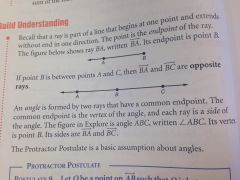
|
|
|
Postulate 9
|
Let O be a point on AB such that O is between A and B. Consider OA, OB, and all the Rays that can be drawn from O on one side of AB. These Rays can be paired with the real numbers from 0-180 so that
1: OA is paired with 0 and OB is paired with 180 2: if OP is paired with X and OQ is paired with Y, then the number paired with angle POQ is |x-y|. This number is called the measure, or the degree measure, of angle POQ |
|
|
Opposite rays
|
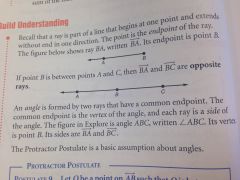
|
|
|
Complementary angles
|
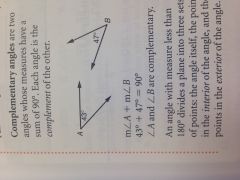
|
|
|
Postulate 9
|
Let O be a point on AB such that O is between A and B. Consider OA, OB, and all the Rays that can be drawn from O on one side of AB. These Rays can be paired with the real numbers from 0-180 so that
1: OA is paired with 0 and OB is paired with 180 2: if OP is paired with X and OQ is paired with Y, then the number paired with angle POQ is |x-y|. This number is called the measure, or the degree measure, of angle POQ |
|
|
Opposite rays
|
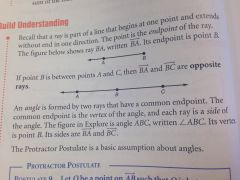
|
|
|
Complementary angles
|

|
|
|
Supplementary angles
|
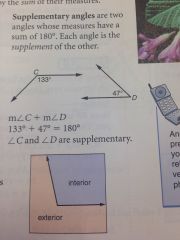
|
|
|
Postulate 9
|
Let O be a point on AB such that O is between A and B. Consider OA, OB, and all the Rays that can be drawn from O on one side of AB. These Rays can be paired with the real numbers from 0-180 so that
1: OA is paired with 0 and OB is paired with 180 2: if OP is paired with X and OQ is paired with Y, then the number paired with angle POQ is |x-y|. This number is called the measure, or the degree measure, of angle POQ |
|
|
Opposite rays
|
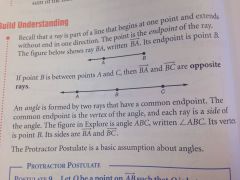
|
|
|
Complementary angles
|
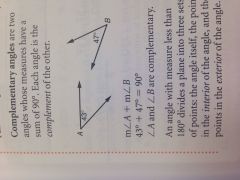
|
|
|
Supplementary angles
|
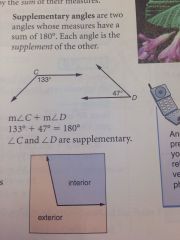
|
|
|
Angle addition postulate
|
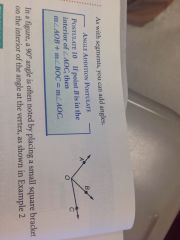
|
|
|
Postulate 9
|
Let O be a point on AB such that O is between A and B. Consider OA, OB, and all the Rays that can be drawn from O on one side of AB. These Rays can be paired with the real numbers from 0-180 so that
1: OA is paired with 0 and OB is paired with 180 2: if OP is paired with X and OQ is paired with Y, then the number paired with angle POQ is |x-y|. This number is called the measure, or the degree measure, of angle POQ |
|
|
Opposite rays
|
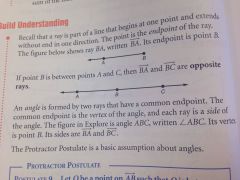
|
|
|
Complementary angles
|
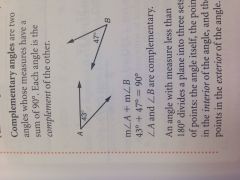
|
|
|
Supplementary angles
|
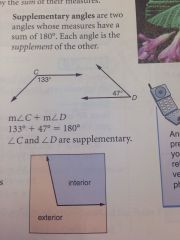
|
|
|
Angle addition postulate
|

|
|
|
Adjacent angles
|
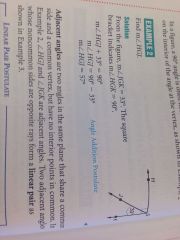
|
|
|
Postulate 9
|
Let O be a point on AB such that O is between A and B. Consider OA, OB, and all the Rays that can be drawn from O on one side of AB. These Rays can be paired with the real numbers from 0-180 so that
1: OA is paired with 0 and OB is paired with 180 2: if OP is paired with X and OQ is paired with Y, then the number paired with angle POQ is |x-y|. This number is called the measure, or the degree measure, of angle POQ |
|
|
Opposite rays
|
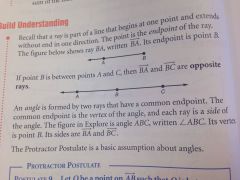
|
|
|
Complementary angles
|
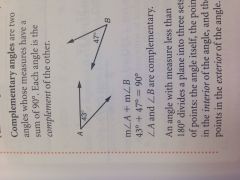
|
|
|
Supplementary angles
|
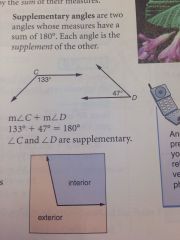
|
|
|
Angle addition postulate
|

|
|
|
Adjacent angles
|
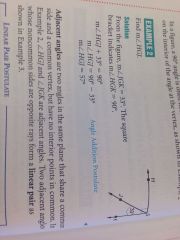
|
|
|
Linear pair postulate
|
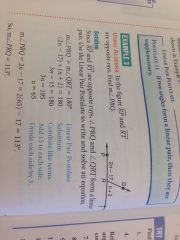
|
|
|
Postulate 9
|
Let O be a point on AB such that O is between A and B. Consider OA, OB, and all the Rays that can be drawn from O on one side of AB. These Rays can be paired with the real numbers from 0-180 so that
1: OA is paired with 0 and OB is paired with 180 2: if OP is paired with X and OQ is paired with Y, then the number paired with angle POQ is |x-y|. This number is called the measure, or the degree measure, of angle POQ |
|
|
Opposite rays
|

|
|
|
Complementary angles
|

|
|
|
Supplementary angles
|
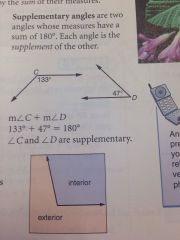
|
|
|
Angle addition postulate
|
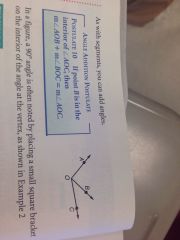
|
|
|
Adjacent angles
|
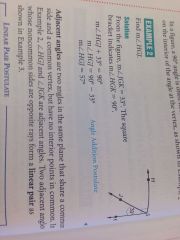
|
|
|
Linear pair postulate
|
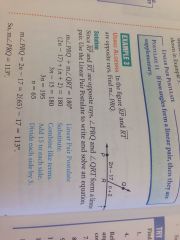
|
|
|
Congruent angles
|
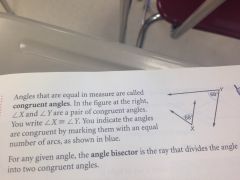
|
|
|
Postulate 9
|
Let O be a point on AB such that O is between A and B. Consider OA, OB, and all the Rays that can be drawn from O on one side of AB. These Rays can be paired with the real numbers from 0-180 so that
1: OA is paired with 0 and OB is paired with 180 2: if OP is paired with X and OQ is paired with Y, then the number paired with angle POQ is |x-y|. This number is called the measure, or the degree measure, of angle POQ |
|
|
Opposite rays
|
|
|
|
Complementary angles
|
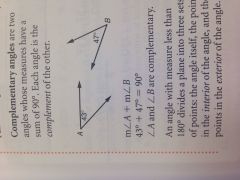
|
|
|
Supplementary angles
|
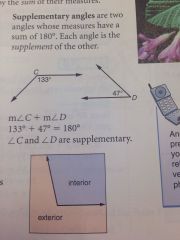
|
|
|
Angle addition postulate
|
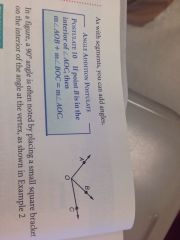
|
|
|
Adjacent angles
|
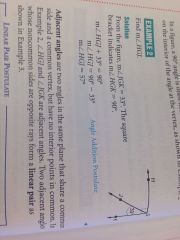
|
|
|
Linear pair postulate
|
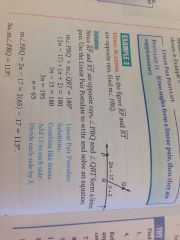
|
|
|
Congruent angles
|
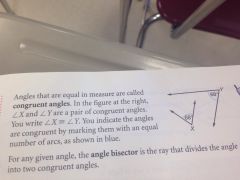
|
|
|
Angle bisector
|
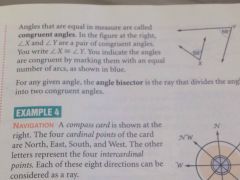
|

